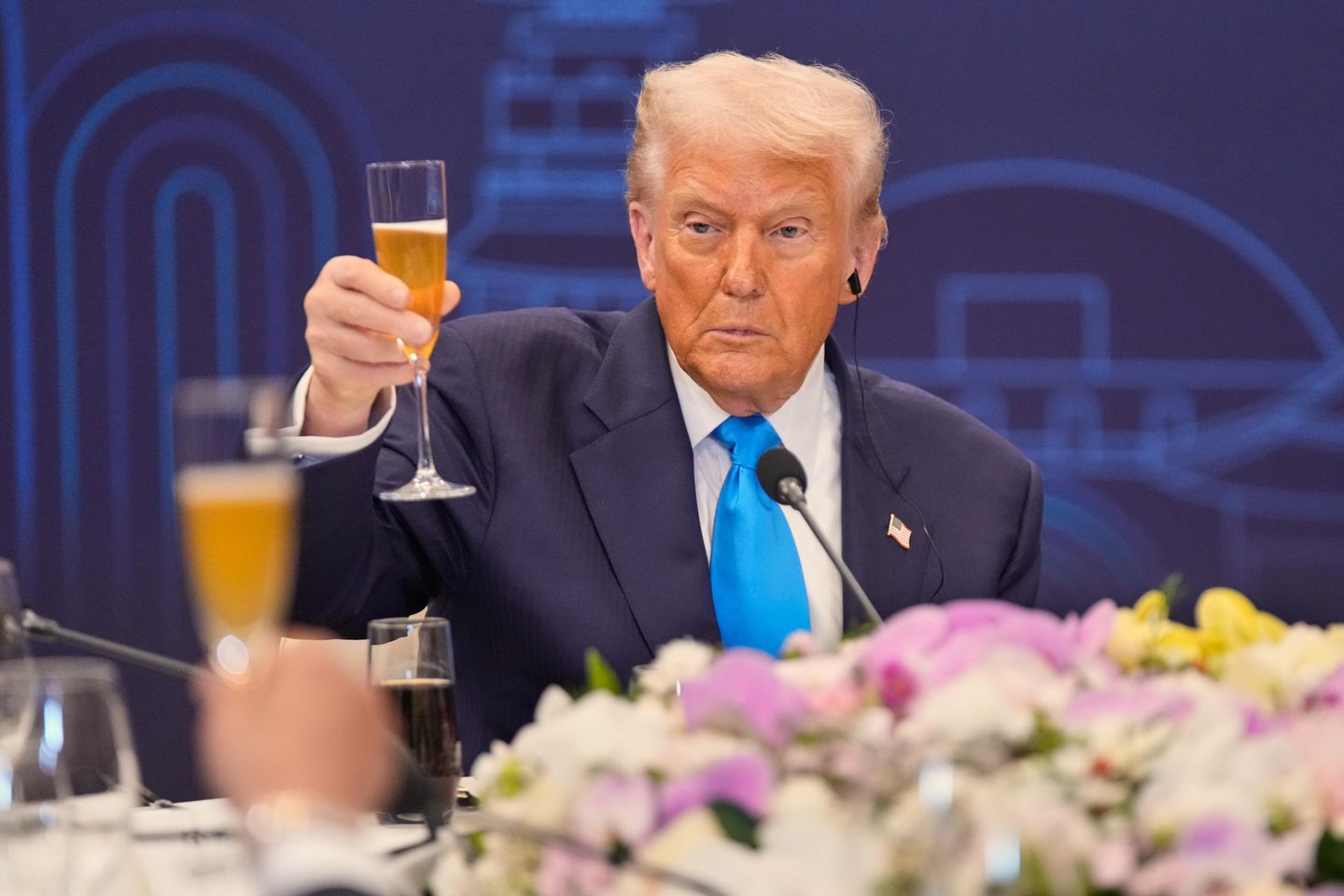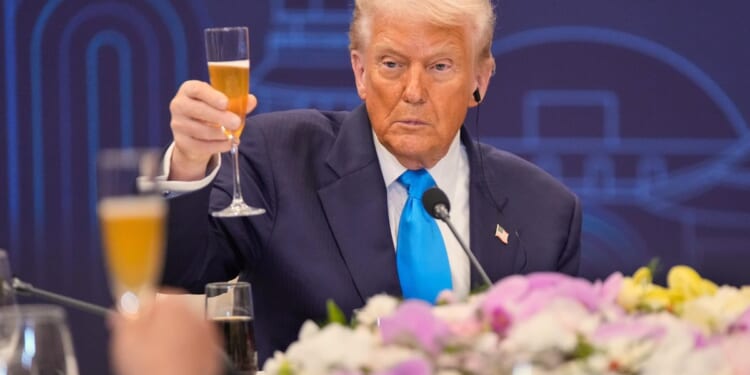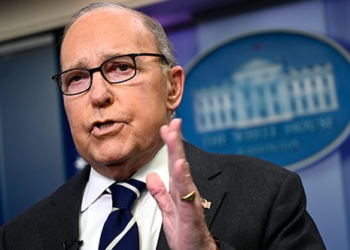
President Trump finalized a thorny trade deal with South Korea and secured deals with Southeast Asian nations to keep minerals flowing to the U.S., while averting a full-blown trade crisis with China during a five-day trip across the Far East.
Mr. Trump’s stop in Japan filled in the lines of an existing deal, with Toyota, Hitachi, Mitsubishi and other top companies lining up to detail their investments in the U.S.
“They’re investing tremendous amounts of money in the United States, like money that we’ve never seen before,” Mr. Trump said on the flight home.
South Koreans presented Mr. Trump with a literal crown, and the president ameliorated a major problem with his political base in the heartland by extracting commitments from China to resume purchases of U.S. soybeans.
Taken together, the successes had Mr. Trump and his top trade official, Jamieson Greer, beaming for the cameras Thursday on the way back to Washington.
Yet the path forward with China remains tenuous, leaving questions about whether the U.S. side made progress or got back to where the administration started with Beijing months ago. Mr. Trump extracted a one-year extension of Chinese exports of rare-earth elements — alongside the farm purchases — during a high-stakes summit with President Xi Jinping in Busan, South Korea.
SEE ALSO: Trump hails success of summit with China’s Xi, with deals on tariffs, rare earths and farm goods
China demanded payment in the form of lower tariffs and shipping fees for every concession it made, and will likely use its near-monopoly of rare earths as a “hammer” over American heads for the foreseeable future, said Wendy Cutler, senior vice president at the Asia Society Policy Institute.
“This is in sharp contrast to the other trade agreements that Trump has concluded in recent days, which were heavily tilted in the U.S. favor,” she said. “Trump has met his match with China, which has shown that two can play at this game.”
China got Mr. Trump to drop a formal trade investigation of its shipbuilding practices for one year, plus a rollback of a Sept. 29 rule that blacklisted some Chinese entities so they could not access U.S. exports.
The White House said Mr. Trump is trying to correct years of unfavorable trade treatment by other nations, and that his use of tariffs as leverage is bringing major global players to the table in meetings like the ones that unfolded during his tour of Asia.
Democrats counter that Mr. Trump’s trade spats aren’t worth the chaos. They point to companies that have increased prices due to the cost of higher customs duties on imported goods and other fallout.
The Senate voted to terminate 50% tariffs on products from Brazil, as consumers complain of higher coffee prices, and 35% levies on Canada, where consumers are boycotting Kentucky-made whiskey and other American spirits.
High tariffs on Chinese goods could put price pressures on toys and other products.
“The president’s incoherent and haphazard use of tariffs has left China with virtually the same tariffs as many of our allies in Southeast Asia and lower tariffs than Canada and India—all just to get back to where we started on rare-earth exports and to secure commitments on fentanyl precursors that were always within China’s capacity,” Sen. Jeanne Shaheen, New Hampshire Democrat, said.
Senate Democratic leader Charles E. Schumer of New York accused Mr. Trump of “patting himself hard on the back for cleaning up a mess he created.”
He called the Asia trip a “total dud,” infuriating Mr. Trump.
“Worked really hard, 24/7, took in Trillions of Dollars and Chuck Schumer said trip was a ’total dud,’ even though he knows it was a spectacular success. Words like that are almost treasonous!!,” Mr. Trump wrote on Truth Social.
Mr. Trump landed in Malaysia on Sunday and departed South Korea on Thursday, with a stop in Japan in between.
Trade wins from the trip included:
• U.S. Trade Representative Jamieson Greer said the U.S. secured trade and minerals deals with Cambodia, Malaysia, Thailand and Vietnam — critical trading partners that serve as an alternative to China in Asia. Previously, Mr. Trump signed a rare-earths deal with Australia to be less reliant on China.
• Mr. Trump hit it off with new Japanese Prime Minister Sanae Takaichi, and Japanese companies outlined U.S. projects under a trade agreement that calls for a $550 billion investment within the U.S.
• After weeks of wrangling, U.S. and South Korean officials finalized a deal that lowers American tariffs on Korean goods and automobiles from 25% to 15% in exchange for a $350 billion investment in U.S. projects. It includes a $200 billion cash investment, plus another $150 billion in U.S. shipbuilding, though disbursements will be capped at $20 billion per year to avoid financial shocks in Seoul.
“Trump leaves Asia with wind in his sails — a string of new trade and mineral agreements and the upcoming G7 meetings on countering China’s rare-earth coercion,” said Craig Singleton, senior China fellow at the nonpartisan Foundation for Defense of Democracies. “For all the talk of Trump as an isolationist, this trip underscores a more muscular realism — transactional, assertive, and unmistakably global.”
Mr. Trump’s summit with Mr. Xi capped the whirlwind tour and produced the most nuanced results.
The meeting diffused tensions over high tariffs and rare-earth controls for one year, but did not result in a grand bargain or delve into Washington’s deeper concerns about Beijing’s command-and-control economy.
“We will have to wait and see whether these statements are simply PR or represent real trade progress,” said Wayne Winegarden, a senior fellow in economics at the Pacific Research Institute.
He said parts of the deal, such as Beijing’s commitment to crack down on precursor chemicals for fentanyl, will be difficult to verify.
“It is unknown whether China will uphold deal provisions such as these. The historical record is not promising,” he said.
Mr. Singleton said the powerful leaders opted for short-term stability over long-term clarity.
“The Trump-Xi meeting delivered symbolism over substance,” he said. “The tariff cut in exchange for a promised fentanyl crackdown buys temporary calm, but it’s transactional relief — not a structural reset. Both sides gave just enough to claim success: Trump gets soybeans and soundbites; Xi retains his rare-earth chokehold for use later.”
The Trump administration said the commitments from China are nothing to sneeze at.
Treasury Secretary Scott Bessent, speaking on Fox Business Network, said the Chinese agreed to buy 12 million metric tons of soybeans this season and 25 million tons annually for the next three years.
China had turned to South America for its soybeans earlier this year, causing panic among American growers who backed Mr. Trump during last year’s election.
The American Soybean Association said the soybean part of the U.S.-China deal is “great news.”
“This is a meaningful step forward to reestablishing a stable, long-term trading relationship that delivers results for farm families and future generations,” ASA President Caleb Ragland said.
Mr. Trump said negotiations over American-made semiconductors remain under discussion.
Critics had been worried that Mr. Trump would forfeit the U.S. edge in artificial intelligence by letting Nvidia sell its advanced Blackwell chips to China, though Mr. Trump said the Blackwell products weren’t involved.
“They’re going to be discussing that with Nvidia,” Mr. Trump said. “We’re sort of the arbitrator or referee.”
Time will tell whether both sides live up to their commitments or if actions by either side lead to a new crisis.










